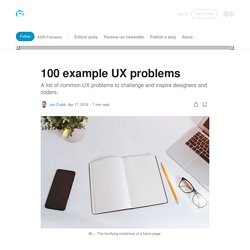

100 example UX problems - UX Collective. A list of common UX problems to challenge and inspire designers and coders.

So you want to practice your design skills? You’ve joined a bootcamp and need a problem to fix? Hiring new designers and want to set them a challenge? Sometimes, its harder to find a problem than a solution. There are a few design problems floating around the internet, but nothing very extensive. The examples here come from all kinds of places including personal experience, but I take no credit for any of them. Some further resources are at the bottom. The challenges run from mundane to weird, and old-fashioned to futuristic, but most are kept as open as possible. Without further ado… Additional Resources.
Make your personas great again in 7 simple steps - UX Collective. Timeline 2.0 — Interaction Design for Sketch – Design + Sketch. Priority Guides: A Content-First Alternative to Wireframes.
How You Can Aid User Scanning by Using Eyebrow Headlines. Are you writing your marketing headlines the way users read online?

An eye-tracking study found that most users don’t read entire headlines. Instead, they scan the left sides of headlines and only read the first few words. Further research discovered most users scan the first two words of a headline. They do this to predict where it’ll lead them before they click the call to action. Users Need Keywords Fast If the first two words don’t hint at what the content is about they’ll not only skip your headline, but your blurb and call to action too. When users hunt for information, their patience and attention span is short. One way to do this is to put keywords in the front of your headlines instead of leaving them at the end. Designers need a better way to write headlines that not only appeal to users, but also give them keywords fast.
Eyebrow Headlines A technique that will give users the keyword cues they need is the use of eyebrow headlines. Eyebrow Styling. 13 incredible tools for creating infographics. Infographic makers will enable you to transform mountains of data into easy-to-read visuals. Information is much more accessible when presented in a well-designed infographic rather than dense reams of data, so people are likely to be much more engaged with the subject. However, it can be time-consuming to put them together. To help you out with that, we've handpicked a range of top infographic maker tools and apps – including paid-for and free options.
Even the free options are surprisingly capable, and many are also aimed at non-designers or complete beginners. Need some inspiration before you begin making your own creation? 01. Price: From free If you need a tool to make infographics quickly and easily for social media then Adobe Spark is for you. Spark uses a drag-and-drop editor which kicks off with a default template. Get Adobe Creative Cloud now. 10 cheat codes for designing User Interfaces – Design + Sketch. I’d probably assume that most of us started in UI design with the littlest knowledge or nothing at all.

But even though the odds were against us at the start, we managed our way through numerous design books and articles to understand how colors, typography, layout etc works. I remember how it is established in us at Make Technology, a UX driven company, that Design can’t be simply explained by colors, shapes, and text. It is a process that has a “Why” behind it, that whenever we create a text bigger, add a shadow, or change the color, there has to be a reason of why things have to be. Thus in this article, I’ll be sharing a list of things I’ve learned from different companies, designers, things I’ve learned in designing user interfaces, and new discoveries I found along the way: *Disclaimer: The following “Don’t” samples provided doesn’t necessarily mean they’re wrong. 1. Font hierarchy is just not about small to big font sizes. So how do I create better contrast? 2. 3. FlowMapp is UX planning tool for creating a visual sitemaps. Laws of UX.